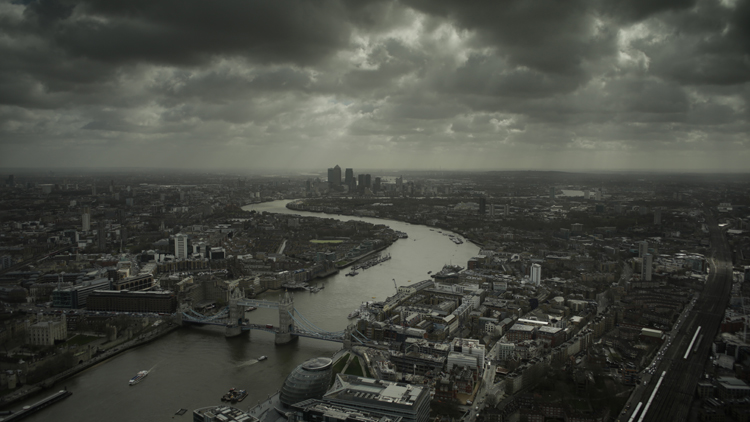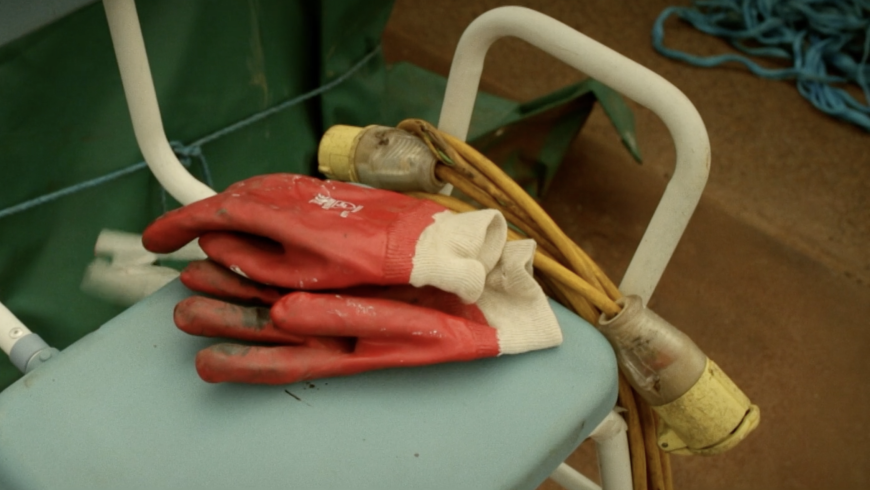Riverrun
Steven Bode
A re-run of Steven Bode’s introductory essay from the Portrait of a River accompanying publication.
Projects
Watch Portrait of a River now on FVU Watch
There is a saying that you can never step into the same river twice. Premised on the notion that the only constant in life is flux, this ageless mantra (rolling out of the ancient past like Old Man River itself) is an eloquent reminder of how time conspires to shuffle us on, no matter how long we might want to linger in the moment, or how much the scene before us appears unchanged. Nothing stays quite as it was, nor can the moment exactly be repeated, even when all the elements are identical. We are different, even if nothing else is. Time flows forward, in its inexorable one-way stream, and we can never row back against the tide. It’s a sentiment that has acted as a watchword for Nikolaj Bendix Skyum Larsen’s film about the Thames, Portrait of a River (2013), and one that haunts the attempt to revisit it (and encapsulate it) in this book.
From the very beginning of this project, Larsen realised that the subject of his ‘portrait’ would never be still enough for him to ‘capture’ it definitively. To stand the best chance of keeping up with this continuously moving target, he would need to move as the river moves: following its surface currents, and plumbing its underlying complexities. The Thames is serpentine, protean, quixotic, deceptive. Although he largely restricts himself, in his travels, to its metropolitan face, or at least that part of it that stretches from the Pool of London to its mouth, thirty miles or so away to sea, Larsen knows he will have his work cut out to gather more than a handful of its ever-changing expressions. The spirit of the Thames, if any such thing can be said to exist, will always be elusive. The thought occurs that if that ‘spirit’ were ever to be accorded a name it might well be elusiveness itself.
It is tempting to cast Larsen, a Dane, as one of the latest in a long line of international artists who have brought an outside eye to the study of London and found a fresh angle on scenes that are particular to the city yet which can often become clouded by over-familiarity. In fact, Larsen was no stranger to the capital, and had lived there for twenty years, before relocating (to Paris) just before the film was shot. The London waterfront was well-covered terrain for him. If he was to go beyond what he already knew, and confer this invitation to look again with a frisson of discovery, he would have to jettison prior expectations, or take his lead from people whose experience of the river was deeper and greater than his. This twofold impulse distinguishes the resulting film, which alternates, in a gently rhythmic to-and-fro, between extended interviews (with watermen, river pilots and local historians) and more abstract visual cameos recording chance encounters and random occurrences observed along the way.
This openness to chance characterises the form as well as the content of the work. ‘Portrait of a River’ is made up of twenty-nine short, discrete sections, of between one and six minutes in length – the jumps between these individual passages both bridging and dividing its flow. Whenever the piece is exhibited in a gallery, as at its premiere staging at the Museum of London in 2013, Larsen’s preference is to let these different chapters play back in shuffle mode; their sequence unpredictable, and unrepeatable. There is also an 80-minute linear version of the film, which zigzags around, upriver then downriver then upriver – no slave to rules, or geography. What this cinema edition can only hint at, however, the randomised playback enacts, following its wandering star in the same way that Larsen trusted his instincts to get to the subject of his work. Free from being funnelled in any one direction, this randomised version literally goes with the flow. The visitor can step into the gallery, but it is unlikely that he or she will see the same sequence of elements twice.
There are normally two ways to journey along a river. The first begins at the source and proceeds to the sea; its widening course suggesting a parallel narrative, in which the river’s progress, from landmark to well-known landmark, is echoed by a historical timeline that advances, against a backcloth of myth and memory, before neatly resolving itself in the present. While this may seem the common-sense route to go, there is an equal desire to push against the prevailing current, and travel backwards from the mouth - the endoscopic analogy nicely suited to a psychogeographic pursuit of hidden pockets and secret histories. ‘Portrait of a River’ follows neither trajectory, as such, but contains elements of both. Centred on a part of the Thames that is inflected by the ebb and flow of the tide, it oscillates back and forth, moving subtly but insistently this way and that.
Rivers may be paragons of movement and symbols of flux but they also convey, as a ripple effect of their ceaseless and restless motion, the intangible promise of recurrence. Stick around at the side of a river for long enough and what goes around may well come around. The Thames, like all rivers, shifts and swirls, dispersing and erasing as it goes, but, as it does so, it dredges up remnants of the past. ‘Portrait of a River’, too, stirs up traces from other times and other places – traces that recur, as motifs, at different points throughout the work. For all its episodic character and its meandering inclinations, ‘Portrait of a River’ subtly hymns those facets of its subject that imply a deeper continuum. A paean to change, and a poetic reflection on the passing of time, Larsen’s opus also rewards those with an urge to return to the river and relive it one more time.
–––
Steven Bode is Director of Film and Video Umbrella.
The Portrait of a River volume is available to purchase here.


